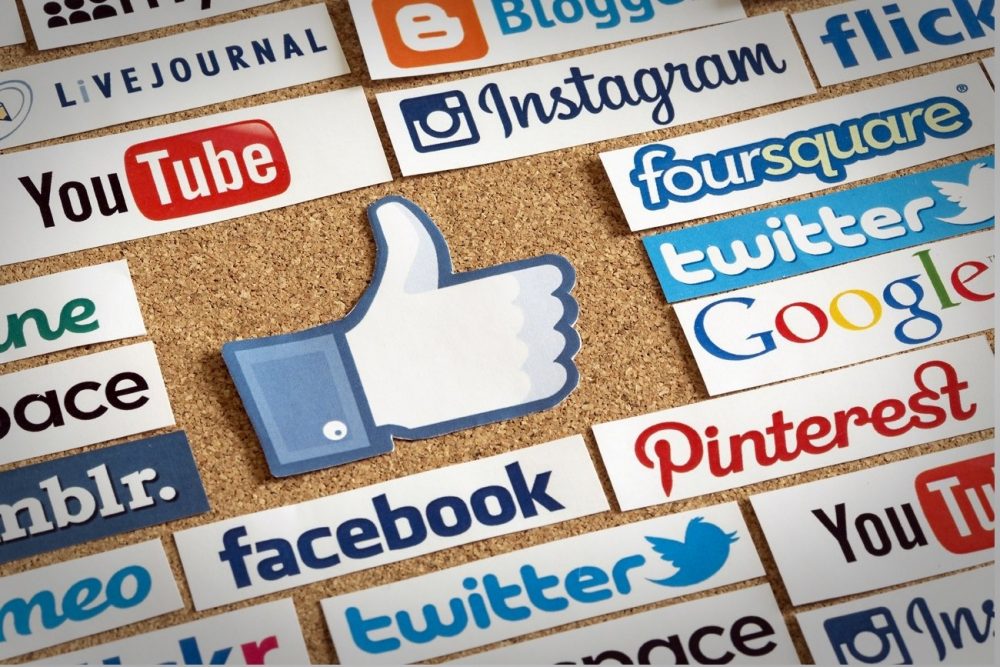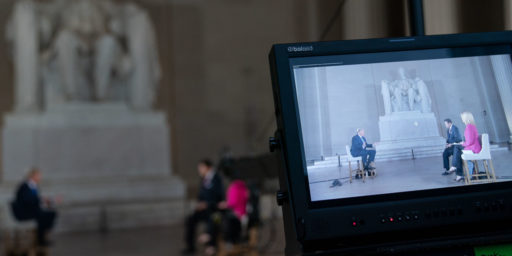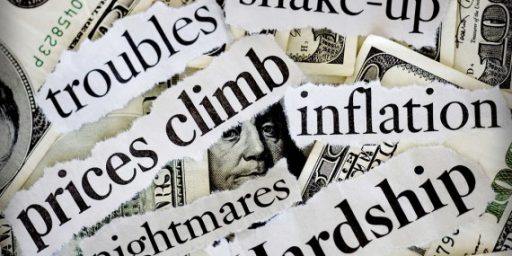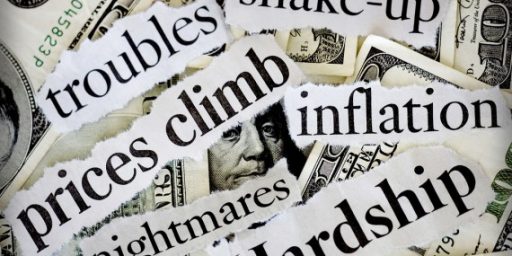Misogyny and Nano-Bubbles
It's increasingly challenging to discuss media coverage because we're all consuming a hand-selected bit of it.

I’ve written quite a bit lately about perceptions of sexism in the 2020 campaign. “Can Coverage of Women Candidates Be Non-Sexist?” “Everything Isn’t Sexism,” and “Does Media Coverage of 2020 Distort Reality?” are the most recent examples.
Kevin Drum comes at it from another angle that more thoughtfully gets at what I was trying to articulate here:
Given the diffuse nature of the modern news media, I haven’t the foggiest how one would go about establishing how much coverage a given candidate is getting. Front page stories in the Washington Post? Minutes on network nightly newscasts nowadays watched mostly by geriatrics? Appearances on Stephen Colbert? Rubin seems to think “cable news coverage” is the metric but, again, there are multiple channels, none of which have particularly large viewership.
Drum writes,
What’s got me interested is an old topic: how social media allows us all to hyperspecialize in what kind of news we consume. Earlier today, for example, I saw a tweet about how the women running for president are being treated differently than the men. That doesn’t seem right to me based on the sense I get from my Twitter feed, but someone else—also liberal, white, middle-class, etc.—with even a moderately different set of people they follow might come to a completely different conclusion. Neither one of us is “right.” Neither one of us could possibly consume enough different news sites to do a serious comparison.
He follows this by refuting several claims of biased treatment against female candidates (Hillary Clinton, Elizabeth Warren, Amy Klobuchar, and Kirsten Gillibrand) and over-the-top coverage of male candidates (Pete Buttigieg and Beto O’Rourke), making arguments very similar to those I’ve been making. But he then circles back to his original point:
So who’s right about this? It’s always been impossible to say for sure, but it seems even more impossible these days because so many of us form vague feelings about things based on what we scan through in our Twitter or Facebook or Instagram feeds every day. But those are hyperspecialized nano-bubbles. In the same way that liberals and conservatives sometimes seem to live in whole different worlds because of Fox News, people who agree about nearly everything can also end up with wildly different views thanks to the power of social media. Even if we all read, say, the New York Times and the Washington Post, our social media feeds have more power to shape our opinions because they’re populated by people we know and trust.
Of course, the same dynamic takes place outside of social media too. There’s a lot of wailing and gnashing these days about whether “the media” reported on the Trump-Russia scandal fairly over the past couple of years. My sense is that the coverage was generally OK, but it turns out that the criticism is mostly aimed at MSNBC, and specifically at Rachel Maddow. Did they blow it? Beats me. I haven’t watched any prime time cable shows for years. I have no idea what they’ve been saying. I consume almost exclusively print media.
So who’s right about this? Again, I don’t know. In one sense, I think it’s fair to say that not all that many people actually watch these cable shows: a few million total, and maybe half a million in the key 25-54 demographic. That’s about 1 percent of the voting-age population. On the other hand, those few million are political junkies who probably have influence out of proportion to their numbers. So maybe it’s fair to say that I’m missing the boat by not watching them and understanding what they’re up to. I wouldn’t dismiss the influence of Fox News, after all.
So what’s the conclusion here? I don’t have one. I warned you about that in my first sentence, didn’t I? Hell, I don’t even know if the nano-bubbles of social media are really any different than the ordinary nano-bubbles of friends and family. What do you think? Social media nano-bubbles seem more powerful and diverse to me, making it even harder than usual to build consensus, but then, that’s just a sense I’ve built up from my own nano-bubble. What do I know?
Like, Drum, all I have to go on here is my own, extremely unrepresentative, experience. But his rationale is quite persuasive. As the amount of available political news and analysis has exploded, the share of it that any of us can consume has shrunk exponentially. We’ve been discussing for years the partisan bubbles that this creates. But, even within those macro-bubbles, there’s only so much we can consume. And it only makes sense that stuff coming from people we’ve specifically chosen to follow on Facebook, Twitter, and whathaveyou would be trusted more.
While Drum’s politics are somewhat to the left of mine, we have very similar media consumption habits. He started blogging shortly before I did and certainly developed a much bigger audience than me but the nature of the medium encourages the consumption of media that one can easily link and, preferably, excerpt. As such, neither of us have watched that much cable news in over fifteen years.
My own nano-bubble is intentional. While I consume a lot of national news through aggregators (Google News, YahooNews, and memeorandum), I focus most of my energy on national security news and commentary from a variety of aggregators and specialty sites, as well as a couple of highly-curated Twitter feeds (Top Reads and Foreign Policy). I follow and trust a wide array of national security professionals and journalists who simply have a different set of interests and experiences than the average American.
My bubble skews highly-educated, professional, white, middle-aged, and male. I’ve deliberately worked the last few years, to diversify that—in particular adding more women to those lists, which has also helped make the feed somewhat younger. It’s one reason why I’m blogging so much on charges of sexism; it’s an issue that a lot of people in my nano-bubble are raising. It’s also why, for example, I’ve paid more attention to Lauren Duca than the OTB commentariat.
None of this is fixable. Indeed, I’m not sure I want to fix it; I’m much happier with my current information diet than the one I had when OTB started in 2003. But it makes broader conversations about the media landscape challenging, to say the least. It’s probably a large part of why I found Jennifer Rubin’s complaints about distorted reality so puzzling: we’re simply watching very different coverage given our tastes and professional interests.





I reject the entire premise that news coverage should track popularity, at least at this stage. Each hopeful announces his candidacy with a cannonball into the media pool, then goes about executing a particular strategy. Some are shaking hands with onlookers over in the far corner, while others are bobbing in the middle and whistling for attention. It’s all relatively boring, and most of us only notice because national reporters must fill minutes and inches. The bar is set pretty low, probably until after the summer ends, and we will be treated to many flavors of the week, the spotlight shining on whoever can break the monotony, however briefly.
We are in such a different media environment than there was in my youth, where there were three network news shows and a local/regional newspaper that carried a lot of wire service stories.
You have a bubble that you curate, and you mostly employ tools that allow that. For most of the population these days, they use Facebook, which is curated for them, based on “engagement”. That is to say, it is specifically tuned to stuff that gets them to react. They aren’t necessarily aware there is a bubble. It’s right there next to Uncle Fred’s update about his fishing trip. Facebook goes so far to tell commercial users that if they want their followers to see their updates, they have to pay up, as well.
There’s a problem with accountability, too. It used to be that when a media source said something unusual, lots of people saw it, and there was pushback, accountability. Not so with so many media sources now. They can narrowly target users who are inclined to credit them, who might well think everyone is seeing this. But nobody else is seeing it, and there’s no cries of foul, no pushback, no rebuttal.
When the media picks and chooses who and what they cover to stay partisan, they will end up destroying themselves. It did not have to be this way. They could have been true journalist, and told the whole truth from the beginning, if they did it for ratings only it is now backfiring on them. Yet what are they doing now? Doubling down on BS.
The problem stems from the vast majority of the public not understanding or accepting they are in such a bubble. It’s not so much a partisan issue as a cognitive one – we seek out things we prefer and offer confirmation bias. It’s a rare soul that deliberately seeks out viewpoints divergent or abhorrent on a regular bias. At most one might watch an hour of FOX / CNN (depending on one’s views) a month and congratulate oneself on being “open-minded”
That being said, the misogyny being cited here is the unconscious bias kind, not the overt and intentional sort. It’s the sort we *all* engage in due to socialization and cultural norms. Of course Kevin Drum is going to be all “meh, it’s subjective and I’m not seeing it personally so agree to disagree” – Kevin Drum is *male*. You can’t see what you’re really not trained to look for. Women has spent their whole lives with these little microaggressions, we instinctively look for them and notice them when they happen. For males, it can zoom right past your heads through no real fault of your own.
The best way I can describe it is the difference between how someone military views their environment versus a civilian. A military individual has been trained to look for threats. Even in a completely safe environment, they may casually scan for weak spots like doors or windows and make sure their back is never towards them if at all possible. Perhaps they’re more sensitive towards noises or motions as their minds run a quick threat index. Nothing big, nothing on the level of PTSD but simple situational awareness from experience. Meanwhile, a civilian doesn’t normally case a room to see where the exits are and doesn’t think twice about sitting with their back to a crowded room. Unless something has happened to them in their lives, it’s literally never occurred to them it might be a potential problem. If the military individual starts insisting on having a specific seat with good sight-lines, the civilian may not understand and wonder what the issue is. Why should they switch? Nothing’s wrong, right? They don’t see a problem – hell, there might not *be* a active problem at the moment. That doesn’t make the military person wrong for pointing out how they perceive the world or it’s importance – it is highlighting the civilian’s lack of ever having to consider such an issue.
Some of the coverage is misogynistic and viewing media through bubbles can only magnify it. We need to be aware of how we’re viewing the world and the fact that just because we’re not seeing something personally doesn’t mean it’s not there. The plural of anecdote is not data, after all. You can accept the premise that media coverage is mildly misogynistic without ever running across evidence in this day and age. Doesn’t mean it’s not happening – it means it’s not on your feed or that it’s in a form you aren’t able to detect yet.
I wonder if most people’s nano-bubbles really are all that “diverse,” ideologically speaking. I tried with my Twitter, but I unfollowed one right wing dude for not shutting up about abortion and ditched a left wing guy because he wouldn’t stop bitching about white people. A win for my blood pressure, no doubt, but by definition a loss of information. Now I’m slightly more ignorant, not less.
I also doubt that nano-bubbles make it “harder than usual to build consensus,” but think they instead have the effect of making the consensus both smaller –that is shared by fewer people– and near impervious to dissent.
First, the news media is a business, and like any other business they need to make money to continue to exist. This has led to a tendency that a blog/bloggers such as those here should understand well: Headlines that lead to clicks and shares matter. News organizations spend a lot of time analyzing data to encourage this, and we simply cannot and should not have a discussion about bias in coverage without keeping this in mind.
On sexism and double standards: yes, of course it exists and you don’t have to look too far to find it. Male politicians are “passionate” while females who exhibit the same qualities are “too emotional.” I think those of us who have had to walk that particular tightrope are probably far more attuned to it than others, but not every observation is sexism.
Regarding coverage–there are plenty of automated media analysis systems out there that use NLP to determine tone and assess text for the content of articles. It seems to me that anyone who subscribes to one of those services (such as Cision) could probably set up the parameters to conduct a pretty thorough review of what’s out there.
Let’s not forget that reporters and the media itself also live in their own nano-bubbles. At least you understand the constraints of your information sources – or at least can identify there are constraints. I continue to see many journalists who continue to believe in their objectivity while living in their own twitter snark and social media bubbles.
The cable TV personalities like Hannity or Maddow are probably more like lite versions of Alex Jones – they are selling bullshit and they know it and don’t openly claim to be objective when asked. But that is a guess on my part since, like you, I haven’t watched cable TV news, much less the “opinion” shows in many years.
We now live in a world where it is possible for everyone to have a common understanding of “the baby shark song”, but not of important national or international affairs. This terrifies me. Moynihan’s classic line about being entitled to your own opinion but not your own facts now sounds quaint and old-fashioned.
I had an impression Hillary’s campaign was a bit blindsided by social media.
Is it a problem for campaigns to track and react to online coverage? Or do their data operations have the tools to track the obscure corners of social media?
And this is why people keep gobbling OxyContin. It feels better, whether or not it is better. You’re happier.
You’ve curated a list of news sources that mostly reinforce your views, but which challenge your views enough that you feel like you’re getting a broader view. You pat yourself on the back for getting information and views on sexism — meanwhile, #metoo has been the largest social change in the past generation and you would be hard pressed to avoid it.
I’m not saying that you’re doing anything different than anyone else does, and you are likely doing a better job of this than the vast majority of people. But right there, in a little tiny fragment of a paragraph, you nail not just the problem, but how the problem perpetuates itself.
I don’t think it can be solved either. Not directly. I do wonder how we can get the most partisan people to make that very conscious decision you made to feel good about yourself by having a few more diverse views in your media diet.
Or how we can trick people into being exposed to their viewpoints while thinking it is reinforcing their own views. (Imagine a show that criticizes Rachel Maddow for going 20% too far, while stealthily exposing the good 80%, all with a fake right wing host.)
Or FEMA re-education camps.
@DrDaveT: Barney Frank’s comment that “arguing with you would be like arguing with a table leg”, however, seems prescient.
@gVOR08: What gave you that impression? Truly curious as I didn’t see it that way.
Why would it be a problem for campaigns to track social media? Clearly they aren’t going to respond to everything, but that’s normal–brands don’t either. Yes, campaigns can and do track social media content. There are a wide range of services that allow you to track by keywords used, etc. (Same with traditional media, and radio/broadcast media. These services have been around for years, you plug in some keywords and get results returned to you–think along the lines of very sophisticated Google News Alerts.)
It’s not as simple as broadening the sources of data, people need to know how to analyze, categorize and absorb that data. I could subscribe to every physics journal in existence and I’d still understand nothing about physics. We’re looking for external fixes to internal problems.
@Jen: I used to work for one of those outfits. When you considered that each office in each city specialized in different areas of media (TV, magazines, newspapers, radio, and they were just setting up an office to start scouring the internet), the amount of information they had at their fingertips was mind boggling. I would’ve liked to stick around to see how big the office for the internet got!
1,800 pages of newspaper a day, minimum, searching for the most outlandish keywords….this was during the Clinton era, so of course there were keywords for all the politicians, but also stranger things like dry eye. You just never knew what was hidden in that database that might get you a hit to help make your article quota.
@James Pearce:
I’m pretty sure what he meant by consensus, was broad consensus, or consensus between groups rather than within groups. Of course it is relatively easy to build consensus in a group you have chosen. The difficulty is building consensus between self selected groups, particularly when that self selection drives the groups ideologically further apart.
To use a simplistic analogue on a subject you seem to be interested in:
If you have a worldwide basketball forum. It will be very difficult to build consensus on the GOAT.
If you have an NBA forum, it might be a bit easier.
If you have a Lakers forum, or a Celtics forum, or a Bulls forum, it will be easier to build consensus within each of those.
Trying to build consensus between the Lakers, Celtics, and Bulls fora, particularly after each has it’s own consensus will be near impossible.
@Grewgills:
True. Expanding a little more, it seems that social media provides the illusion of consensus when, in fact, there’s a lot of disagreement. Take that “bread sliced bagel” thing that blew up the other day. Yes, it was all very cheeky, but almost immediately there was a consensus that bread slicing your bagels is wrong, a crime not just against bagels but gastronomy itself.
And me, being the contrarian weirdo I am, saw the bread sliced bagel and thought, “ah, finally, the right portion of bagel.” And I’m sure someone else was thinking, “I like my bagels bread sliced because it maximizes the surface area for the shmear.” And another person was thinking, “Who gives a shit how someone slices their bagels?”
But you didn’t hear any of those people weigh in on the great bread sliced bagel argument. The consensus had been formed. And they were outside of it. Same thing is happening with the nano-bubbles. The people inside them think there’s consensus.
The people outside know there’s not.
(I dug the basketball analogy, btw.)
@Gustopher:
I get a rather broad range of political news and commentary. But I’ve tended to sort it according to style rather than viewpoint. That is, I pretty much ignore the screamers and focus on more analytical, professional voices. But that does mean that I tend to be late to understand the influence of, say, an Alex Jones.
Mostly, though, I’m curating the type of content I’m interested in and get tons more of it than was possible before. But I miss out on some stories I would have found serendipitously in the old days. The main thing I miss now, because of my eschewing of TV, is seeing various politicians talking.
@Jay L Gischer: Yes, the days of professional news reporting and presenting are long over. Somewhere along the line things changed. Now it is slanted opinions, political driven reporting, hollering at guests and fellow commentators. It is a negative, acidic atmosphere of sleaze, scandalisms, and lowest common denominator type of programs. “Gotcha” type questions are now normal. This is hurting our country.
We used to have Charles Kuralt “On the Road” which gave a view of real Americana. It was uplifting, inspiring, and made people feel good. That is what we need today. Our nation needs more news about the good things going on today, instead of stuff like that “Stormy Daniels” garbage that should have never been put on any tv stations. The main stream “news” networks should run more stories about good news: people helping others, medical breakthroughs, self help advice, our military heroes, teachers, police, and firemen who are heroes, and some news about pets! Hourly reporting on that sort of thing would end the caustic atmosphere in this country.
Read “On the Road” by Charles Kuralt. That’s what the country needs.
@gVOR08:
I would suspect that the bigger problem in the case you cite might be resistance to believing that social media has impact. For example, I don’t use ANY social media, so I would have difficulty believing that it matters–which, in fact, I don’t believe it does–except to those whose virtual life is more important than their real one. Pathetic. Sad.
” maximizes the surface area for the shmear.”
I suspect that’s probably an illusion, but I haven’t the desire to do the math to figure it out, so I’ll just go on in ignorance conventionally slicing the three or four bagels I eat in a year. (Which I usually use to make sandwiches anyway.)
@Michael Reynolds:
Definitely this. The internet and all our sources of information today give us the illusion of knowledge and allow us to find and cherry-pick the evidence that fits our own conclusions. This makes it easier for us to dismiss alternative viewpoints, wave away competing facts, and conclude that those with different opinions are bad people or are just stupid. It’s cognitively very difficult to break out of that dynamic.
@Just nutha ignint cracker:
You can slather on waaaaay more shmear on six to eight 2″ by 4″ cross sections than you can on one 4″ by 4″ cross section. Too much shmear, maybe.